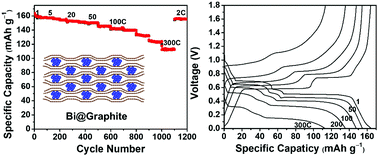Intercalation of Bi nanoparticles into graphite results in an ultra-fast and ultra-stable anode material for sodium-ion batteries†
Abstract
Sodium ion batteries (SIBs) have been revived as important alternative energy storage devices for large-scale energy storage, which requires SIBs to have a long cycling life and high power density. However, the scarcity of suitable anode materials hinders their application. Herein, we report a bismuth intercalated graphite (Bi@Graphite) anode material, which is substantially different from the previously reported metal@Graphene. In Bi@Graphite, the Bi nanoparticles between graphite interlayers enhance the capacity, while the graphite sheath provides a robust fast electronic connection for long cycling stability. The Bi@Graphite possesses a safe average storage potential of approximately 0.5 V vs. Na/Na+, delivers a capacity of ∼160 mA h g−1 at 1C (160 mA g−1), exhibits outstanding cycling stability (ca. 90% capacity retention for 10 000 cycles at 20C), and can maintain 70% capacity at 300C (∼110 mA h g−1 at 48 A g−1), which is equivalent to full charge/discharge in 12 s. Bi@Graphite demonstrates the highest rate-capability ever reported among all anodes for SIBs. Detailed characterization results indicate that the unique Bi nanoparticle-in-graphite structure and the fast kinetics of ether co-intercalation into graphite are responsible for these significant improvements, which could translate into SIBs with excellent power densities.



 Please wait while we load your content...
Please wait while we load your content...